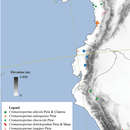Description
provided by Phytokeys
Tree 8–20 m tall, 5–13 cm diam.; young twigs and petioles densely covered with appressed or erect golden to whitish hairs to 0.4 mm long. Leaves: petioles (6-)10–20 by 3–5 mm; lamina elliptic to obovate (24-)32–50 by 11–21 cm (index 2.2–2.8), chartaceous, pale brownish-green to greyish-green above, pale brownish-green below, glabrous above, veins sparsely to rather densely covered with appressed golden to whitish hairs to 0.5 mm long below, base obtuse to rounded, apex acuminate (acumen 15–40 mm long), primary vein 2–4 mm wide at widest point, secondary veins 10–13, intersecondary veins 1–3, distance between from 4 mm at the base to up to 40 mm closer to the apex, angles with primary vein from 50–70° at the base to 45–55° closer to the apex, not branching forming mostly distinct loops, smallest distance between loops and margin 2–7 mm, tertiary veins percurrent. Inflorescence of single flowers, solitary (or clustered in groups of 2), on leafy or leafless twigs; peduncles 2–3 by ca. 2 mm (in flower), 2–4 by 2.5–3 mm (in fruit); pedicels 10–20 by ca. 2 mm (in flower), 13–27 by 2.5–3 mm (in fruit), peduncles and pedicels sparsely to densely covered with appressed golden hairs to 0.4 mm long; single lower bract, ovate, ca. 2 by 1.5 mm, acute, often persistent, outer sides of bracts, of sepals and of petals densely covered with appressed golden hairs to 0.6 mm long; upper bract in the lower half of the pedicel, broadly to depressed ovate, 2–3.5 by 1.5–2 mm, acute; closed flower buds globose; flowers pale green, sepals light brownish-green in vivo, outer side of sepals and petals dark yellow or greyish-green, inner side reddish-brown or dark brown in sicco; sepals free, ovate to broadly ovate, appressed or patent, 7–10 by 7–8 mm, obtuse, often persistent, with prominent venation; outer petals elliptic, 17–29 by 10–16 mm, obtuse, inner petals narrowly elliptic, 28–33 by 9–12 mm, obtuse; androecium not seen; stamens 1.6–1.9 mm long, connective appendage 0.5–0.8 mm wide; gynoecium not seen. Monocarps 3–14, ellipsoid to broadly ellipsoid, asymmetrical, 16–22 by 10–13 mm, yellow, orange, red or pale brown in vivo, blackish-brown to black in sicco, with an excentric apicule; stipes 1.5–4 by 2 mm; fruiting receptacle 4–10 mm diam.; monocarps, stipes and receptacle sparsely to rather densely covered with appressed brown hairs to 0.2 mm long. Seeds ellipsoid, yellowish-brown, very shallowly pitted, ca. 16 by 10 mm, raphe sunken, irregular.
- license
- cc-by-3.0
- copyright
- Michael D. Pirie, Lars W. Chatrou, Paul J. M. Maas
- bibliographic citation
- Pirie M, Chatrou L, Maas P (2018) A taxonomic revision of the Neotropical genus Cremastosperma (Annonaceae), including five new species PhytoKeys (112): 1–141
- author
- Michael D. Pirie
- author
- Lars W. Chatrou
- author
- Paul J. M. Maas
Distribution
provided by Phytokeys
Pacific coast of Colombia (Valle del Cauca).
- license
- cc-by-3.0
- copyright
- Michael D. Pirie, Lars W. Chatrou, Paul J. M. Maas
- bibliographic citation
- Pirie M, Chatrou L, Maas P (2018) A taxonomic revision of the Neotropical genus Cremastosperma (Annonaceae), including five new species PhytoKeys (112): 1–141
- author
- Michael D. Pirie
- author
- Lars W. Chatrou
- author
- Paul J. M. Maas

